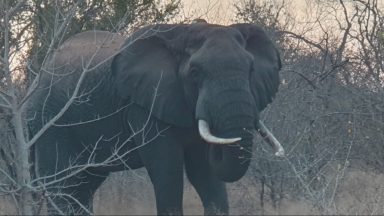A team from Peace Parks Foundation’s Head Office in South Africa is visiting Zinave National Park on a content collection mission. With SD cards emptied and camera batteries charged, they jump on board a rather untraditional-looking game drive vehicle and head out for the evening. As the sun starts to sink below the horizon, Zinave’s Technical Advisor, Justin Landrey, who knows the park like the back of his hand, confidently drives the crew into darkness. It’s slow going, but their patience is soon rewarded as they are treated to a magnificent sighting – a crash of white rhino.
A Crash In The Road
Videographer Dylan Haskin and Communications Coordinator, Lésa van Rooyen quickly get to work filming these gentle giants. All the while, Communications Manager, Lise-Marie Greeff-Villet, doesn’t miss a beat in filming the behind-the-scenes action.
This small group of very relaxed-looking white rhino form a part of Zinave’s founder population that was translocated here last year. Now, with both black and white rhino reintroduced back into the park, Zinave has become Mozambique’s first Big 5 national park in decades.
The Importance Of Rhino In The Landscape
Rhinos are a keystone species – an organism that helps define an entire ecosystem by performing many important biological services. These large herbivores consume a vast amount of food. In fact, we’re talking over 50 kilograms of food every day. What comes in must go out, and this, of course, goes back into the soil. Their dung contains many essential nutrients and minerals for insects that help to break it down and turn it into valuable fertiliser.
Rhinos also regularly enjoy mud baths which help to protect them from the sun and remove ticks from their skin. By wallowing around, the rhinos help to keep these waterholes which can be a valuable water source during the drier season, open for other animals.
Being an iconic species, rhinos are an important tourism attraction that generates significant revenue for many national parks in Africa. With tourism development plans in the pipeline for Zinave, these grey giants will attract many visitors to the park. This will create employment opportunities for the local communities and sustain a flourishing wildlife economy where humans and nature thrive!


